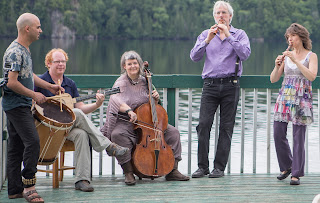Indianapolis Early Music Festival: A spirited 17th-century tour of two hemispheres' musical interaction by Ensemble Caprice
Cultural clashes often beget cultural amalgamation and new syntheses that are impossible to imagine without one cherished tradition rubbing up against another.
Ensemble Caprice, a Montreal group led by charismatic recorder player Matthias Maute, explored the theme here Sunday with particular emphasis on the 16th- and 17th-century effects on European music of exposure to the New World. With the piquant title of "Salsa Baroque: Music of Latin America and Spain," the six musicians (including soprano guest Esteli Gomez) presented a smoothly integrated concert to a well-filled Basile Auditorium at the Indiana History Center. It was the second concert in the current Indianapolis Early Music Festival.
Maute wove a spoken narrative throughout the program. It had touches of poetry about it, asking the audience to imagine itself facing the adventure of travel to the New World at the dawn of European exploration, conquest, and settlement. The performance had begun with a gradual assembling of the ensemble onstage, starting with David Jacques, baroque guitar, in ¡Jacaras! with hand-clap punctuation by Susie Napper before she got to her cello.
Once all six musicians were onstage, the musical adventure began at the beginning of art music in this hemisphere, with a performance of a processional number, Hanacpachap cussicuinin — the first polyphonic piece published (1631, Peru) in the Americas, Maute's program note tells us. It was the first opportunity of several to appreciate Gomez's adept, glowing solo soprano.
Another vocal outing followed after a few short instrumental pieces, in which the balance and vivid expressiveness of the ensemble could be appreciated. Maute and fellow flutist Sophie Lariviere took the sometimes intricate top lines with aplomb, supported by Jacques, Napper, and percussionist Ziya Tabassian. The soprano's second showcase was a nostalgic song, "Doulce memoire," that displayed her steady, crystal-clear tone and natural phrasing.
Every time she was involved in the concert, she lent a similar warmth and communicative power: In a lullaby in the Aztec language, in a "madness" duet with Maute coordinated from one side of the hall to the other, and in the finale, a Christmas jubilee characterized by well-blended African and European elements.
The ensemble did not seem unduly hampered by the absence of some percussion instruments in the first half. Drums that were essential toward the end of the program arrived late at the airport, and weren't available till after intermission, when they were brought onstage in a mock-processional. Domenico Zipoli's three pieces offering a depiction of battle — chosen to signify the conquest of Peru in 1532 under Francisco Pizarro — made stirring use of the tardily delivered percussion, expertly managed by Tabassian.
Attractive "theater" was present near the end, when Maute roamed the aisles carrying a lantern and singing in German (his native language) the song of a night watchman as one of a set of chaconne variations by the Austrian composer Heinrich Isaac. It was done with flair and good taste, and underlined a point that seemed evident by concert end: Ensemble Caprice is not a band inclined to hide its light under a bushel. It places its artistry in a high position, where it gives light to the whole room.
 |
| Montreal-based Ensemble Caprice is led by Matthias Maute (second from right). |
Maute wove a spoken narrative throughout the program. It had touches of poetry about it, asking the audience to imagine itself facing the adventure of travel to the New World at the dawn of European exploration, conquest, and settlement. The performance had begun with a gradual assembling of the ensemble onstage, starting with David Jacques, baroque guitar, in ¡Jacaras! with hand-clap punctuation by Susie Napper before she got to her cello.
Once all six musicians were onstage, the musical adventure began at the beginning of art music in this hemisphere, with a performance of a processional number, Hanacpachap cussicuinin — the first polyphonic piece published (1631, Peru) in the Americas, Maute's program note tells us. It was the first opportunity of several to appreciate Gomez's adept, glowing solo soprano.
 |
| Guest soprano soloist Esteli Gomez added much to Ensemble Caprice's program. |
Every time she was involved in the concert, she lent a similar warmth and communicative power: In a lullaby in the Aztec language, in a "madness" duet with Maute coordinated from one side of the hall to the other, and in the finale, a Christmas jubilee characterized by well-blended African and European elements.
The ensemble did not seem unduly hampered by the absence of some percussion instruments in the first half. Drums that were essential toward the end of the program arrived late at the airport, and weren't available till after intermission, when they were brought onstage in a mock-processional. Domenico Zipoli's three pieces offering a depiction of battle — chosen to signify the conquest of Peru in 1532 under Francisco Pizarro — made stirring use of the tardily delivered percussion, expertly managed by Tabassian.
Attractive "theater" was present near the end, when Maute roamed the aisles carrying a lantern and singing in German (his native language) the song of a night watchman as one of a set of chaconne variations by the Austrian composer Heinrich Isaac. It was done with flair and good taste, and underlined a point that seemed evident by concert end: Ensemble Caprice is not a band inclined to hide its light under a bushel. It places its artistry in a high position, where it gives light to the whole room.


Comments
Post a Comment